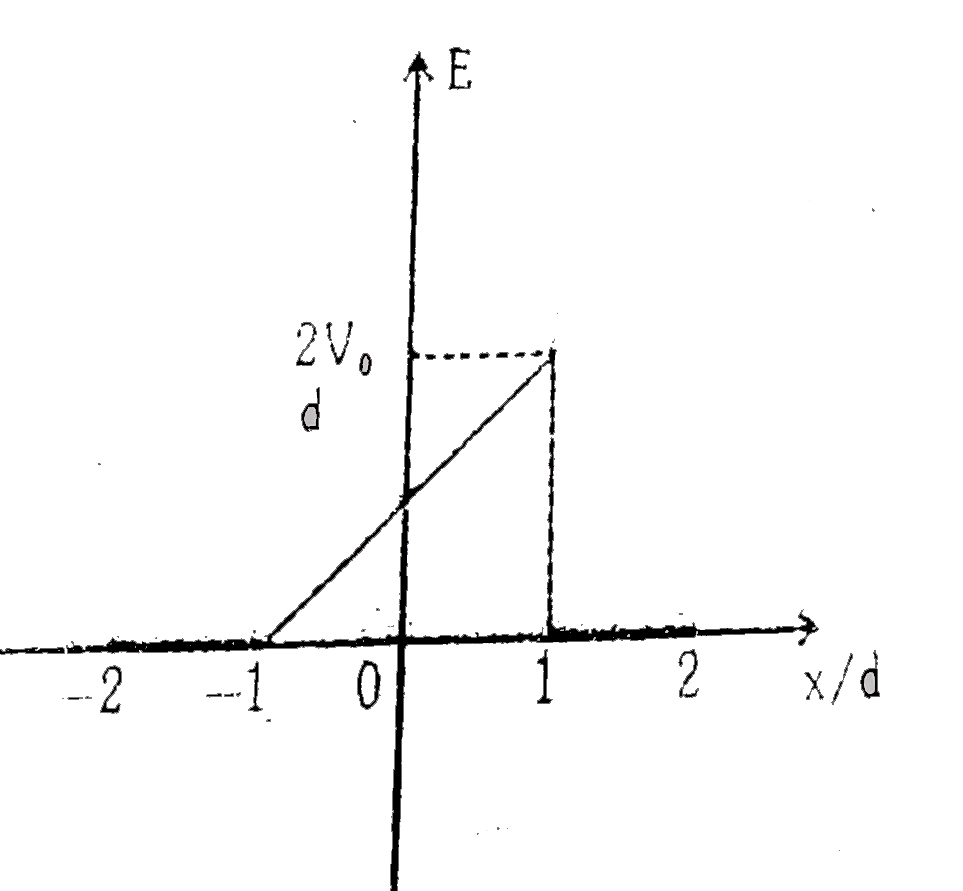The electric potential V(z,y,z) for a planar charge distribution is given by:
V(x,y,z)=⎧⎪
⎪
⎪
⎪
⎪
⎪
⎪⎨⎪
⎪
⎪
⎪
⎪
⎪
⎪⎩0for x<−d−V0(1+xd)2for −d≤x≤0−V0(1+2xd)for 0≤x<d−3V0for x>d
where −V0 is the potential at the origin and d is a distance. Graph of electric field as a function of position is given as
A

B

C

D

Video Solution
Text Solution
The correct Answer is:A
E=−dvdx
|
Topper's Solved these Questions
- MISCELLANEOUSBOOK - ALLENCHAPTER - MISCELLANEOUSEXERCISE - Exersice-03
7 Videos
- MISCELLANEOUSBOOK - ALLENCHAPTER - MISCELLANEOUSEXERCISE - ASSERTION-REASON
18 Videos
- MISCELLANEOUSBOOK - ALLENCHAPTER - MISCELLANEOUSEXERCISE - Part -II Example Some worked out Examples
1 Videos
- KINEMATICS (MOTION ALONG A STRAIGHT LINE AND MOTION IN A PLANE)BOOK - ALLENCHAPTER - KINEMATICS (MOTION ALONG A STRAIGHT LINE AND MOTION IN A PLANE)EXERCISE - BEGINNER S BOX-7
8 Videos
- PHYSICAL WORLD, UNITS AND DIMENSIONS & ERRORS IN MEASUREMENT BOOK - ALLENCHAPTER - PHYSICAL WORLD, UNITS AND DIMENSIONS & ERRORS IN MEASUREMENT EXERCISE - EXERCISE-IV
8 Videos
Similar Questions
Knowledge Check
Let V0 be the potential at the origin in an electric field →E=4ˆi+5ˆj. The potential at the point (x,y) is
AV0−4x−5yBV0+4x+5yC4x+5y−V0D−4x−5yLet V0 be the potential at the origin in an electric field →E=Exˆi+Eyˆj. The potential at the point (x,y) is
AV0−xEx−yEyBV0+xEx+yEyCxEx+yEy−V0D(√x2+y2)√E2x+E2y−V0The electric potential at a point (x,y,z) is given by V=−s2
A→E=ˆi(2xy−z3)+ˆjxy2+ˆk3z2xB→E=ˆi(2xy+z3)+ˆjx2+ˆk3xz2C→E=ˆi2xy+ˆj(x2+y2)+ˆk(3xz−y2)D→E=ˆiz+ˆjxyz+ˆkz2
Electric potential in a region of space is given by V=3x2V. What will be electric field intensity at a point P (2 m, 0).
View SolutionGiven fuction,{x2for0≤x<1√xfor1≤x≤2
Evaluate ∫20f(x)dx.
View SolutionThe electric potential at any point x,yanz in metres is given by V=3x2. The electric field at a point (2,0,1) is
View SolutionThe electirc potential at a point (x,y,z) is given by
V=−x2y−xz3+4
The electric field →E at that point is
View SolutionThe electric potential V at any point ( x,y, z) in space is given by V=4x2V . The electric field E (in Vm) at the point ( 1,0,2) is
View Solution
